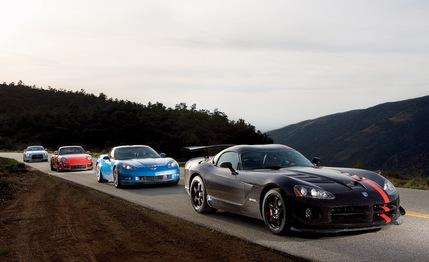
 Comparison Tests
Comparison Tests
Behold four machines sitting on the pointy end of a horsepower skyrocket that lifted off sometime in the 1980s and hasn’t hit the chutes yet.
For now, anyone can buy these vehicles by flashing a valid driver’s license and a healthy checkbook. But this may be it. The last act. The apogee right before reentry, when post-peak oil prices and carbon-emissions limits and general economic malaise threaten to make memories out of 500-horsepower cars. Maybe someday you’ll bore grandchildren with tales of Porsche GT2s practically falling out of trees for just $198,875. Is it 1971 all over again? Who knows? Maybe you’ll be telling them from the back seat of their parents’ 700-hp minivan.
These days, the only certainties are that factories still make fast cars, magazines still review them, and the public still buys them. Determined not to shirk our duty, we gathered these sharp darts for some track work and desert road running. They have little in common except being the heaviest ordnance currently sold by their respective brands. We didn’t say our duty was particularly tough.
With the new 638-hp 2009 Chevrolet Corvette ZR1 still months off, the 505-hp Corvette Z06 became the old man in our quartet, new in late ’05 as an ’06. Aluminum-frame trusses, a cast magnesium roof, and carbon-fiber floorboards and front fenders help make it a very special Vette, as does the 505-hp, LS7 7.0-liter dry-sump V-8. Chevy fitted $5545 in convenience and Bose-audio options to our Jetstream Blue Metallic example (the stratospheric paint option runs $750).
The American Club Racer (ACR) badge was first pasted onto Dodge Vipers in 1999, and the mission brief hasn’t changed: Put Viper owners on the track. The newest ACR upholds the legacy with an assortment of name-brand racer bits, including KW Suspensions coil-over shocks with jounce, rebound, and ride-height adjustment; StopTech slotted rotors with Brembo calipers; Michelin Pilot Sport Cup pseudo-slicks (size 295/30— in front!); and a carbon-fiber front splitter and rear wing that produce a claimed thousand pounds of downforce at 150 mph. The single option on our car: a red stripe down the driver’s center line, $1650.
Our third instrumented test of Nissan’s freshly unwrapped GT-R starts here. By now you should be able to quote the relative percentages of steel, cast aluminum, and carbon fiber in the GT-R’s body (roughly 80, 15, and 5, respectively), recite the front-axle torque-split spread in the electronic all-wheel-drive system (10–50 percent), and name the brake-caliper paint supplier (we have no idea). The big option is the $2050 Premium pack, including navigation and an 11-speaker Bose audio boombox. This car has it.
Porsche’s long staircase of models currently tops out at the 911 GT2. Its 3.6-liter boxer-six has 50 more horsepower than the 480-hp all-wheel-drive 911 Turbo, but the GT2 uses two fewer wheels to apply its 505 pound-feet of torque to the pavement. Sounds like a formula for carnage-filled YouTube videos, except that the GT2 has fast-acting traction and stability control, plus launch control. We’ve got $6315 in options here, including $1815 black-painted wheels, $1250 in body-color console and dash trim, and $340 in risqué red seatbelts. Every car would go quicker with red seatbelts.
We have four dissimilar cars with a $126,350 price spread. Their collective technology is such that only one, the Viper, carries a gas-guzzler penalty ($1700). Actually, ranking them proved quite tough, but we do this for God and country.